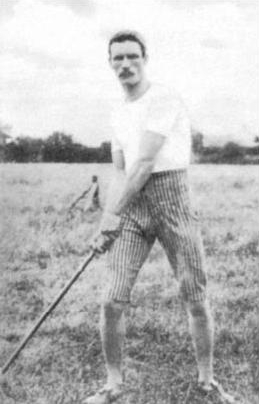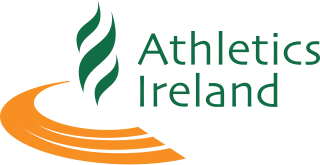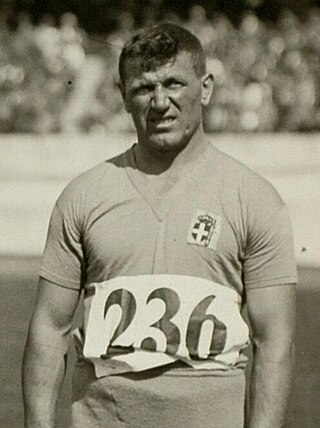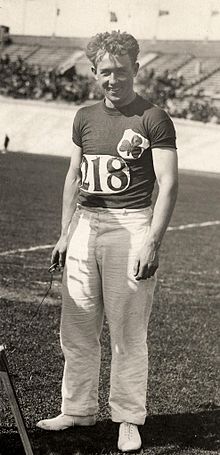
John Joseph Flanagan was an Irish-American three-time Olympic gold medalist in the hammer throw, winning in 1900, 1904, and 1908.
Peter O'Connor was an Irish track and field athlete who set a long-standing world record for the long jump and won two Olympic medals in the 1906 Intercalated Games.

Representation of the island of Ireland at the British Empire Games has varied:

Thomas Francis Kiely was an Irish athlete. Kiely won gold in the all-round at the 1904 Summer Olympics in St. Louis, Missouri representing Great Britain and Ireland, making him the first multi-event track and field champion of the Modern Olympic Games

James Sarsfield Mitchel was an Irish-born American field athlete who competed in the 1904 Olympics. He was one of a group of Irish-American athletes known as the "Irish Whales."

Denis Horgan was a champion Irish athlete and weight thrower, born in Banteer, County Cork, who competed mainly in the shot put.

Ossian Esaias Skiöld was a Swedish hammer thrower who competed at three Olympic Games.
The National Athletic and Cycling Association (NACA or N.A. and C.A.), from 1990 the National Athletic and Cycling Association of Ireland (NACAI or NACA(I)) was a federation of sports clubs in the island of Ireland practising athletics or bicycle racing or both. It existed from 1922 to 2000, though for most of the period it was not the sole governing body in Ireland for either sport. Its refusal to recognise the partition of Ireland got it expelled from the International Amateur Athletics Federation (IAAF) and the Union Cycliste Internationale (UCI). Clubs formerly in the NACAI are now affiliated to Athletics Ireland or Cycling Ireland, each formed by the merger of the NACAI with rival bodies respectively affiliated to the IAAF and the UCI.

Maurice Davin was an Irish farmer who became co-founder of the Gaelic Athletic Association. He was also the first President of the GAA and the only man ever to serve two terms as president.
Patrick Joseph Bermingham was an Irish police officer and sportsman, specialising in the discus. He was from Moyasta in County Clare and joined the Dublin Metropolitan Police.

Simon Peter Gillis was an American track and field athlete, a member of the New York Athletic Club, and the New York City Police Department. He was one of a group of athletes known as the Irish Whales and frequently kept company with members of the Irish American Athletic Club. He competed in weight throwing events in the 1904, 1908 and 1912 Summer Olympics.

Anita Włodarczyk is a Polish hammer thrower. She is the 2012, 2016 and 2020 Olympic champion, and the first woman in history to throw the hammer over 80 m; she currently holds the women's world record of 82.98 m. She is considered the greatest female hammer thrower of all time.

The men's hammer throw event was part of the track and field athletics programme at the 1928 Summer Olympics. The competition was held on Monday, July 30, 1928. Sixteen hammer throwers from eleven nations competed. The maximum number of athletes per nation was 4. The event was won by Pat O'Callaghan of Ireland, the first gold medal for the nation at the Olympics since it started competing independently in 1924 and the first time the event was won by a non-American. Ossian Skiöld of Sweden took silver, the nation's second medal in the event after another silver in 1920. The Americans, who had earned a gold medal and at least one other medal in each of the previous six hammer throw competitions, took only a bronze this time, with Edmund Black finishing third.
Banteer GAA is a Gaelic Athletic Association club which is based in the village of Banteer in County Cork, Ireland. The club plays hurling and is affiliated with Lyre Gaelic Football Club from the same parish. Founded in 1887, the club competes in the Duhallow Junior A Hurling Championship.
Tullylease GAA is a Gaelic Athletic Association club based in the village of Tullylease in the north-west of County Cork, Ireland which forms part of the parish of Milford, Freemount and Tullylease. The club plays in the Duhallow division and competes in both Hurling and Gaelic Football competitions. As of 2024, the club's football team competes in the Duhallow Junior C Football Championship. Tullylease has not fielded a hurling team since 2017.

Athletics Ireland, officially the Athletic Association of Ireland or AAI, is the governing body for athletics in Ireland, with athletics defined as including track and field athletics, road running, race walking, cross country running, mountain running and ultra distance running. The organisation's jurisdiction covers the whole island of Ireland and it is affiliated to the International Association of Athletic Federations. Its remit is to promote athletics from recreational running, schools competitions and to support elite athletes in international competitions.

Johan Gunnar Jansson was a Swedish hammer thrower who competed at two Olympic Games.

Armando Remigio Maria Poggioli was an Italian discus thrower and hammer thrower who competed at three Olympic Games.
Fernando Giuseppe Maria Vandelli was an Italian hammer thrower who competed at the 1932 Summer Olympics.
William T. Britton was an Irish athlete.












